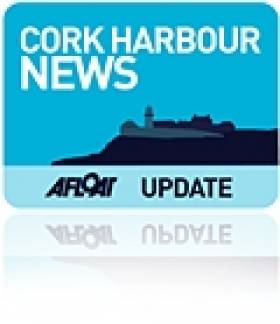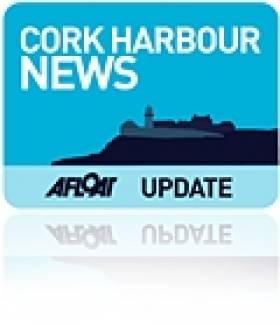Displaying items by tag: Emer sails away
#EmerSailsAway – As previously reported, M.V. Emer which departed Cork for the final time yesterday, has set a course bound for Nigeria, to begin a first-time change in her career since commissioning into Naval Service in 1978, writes Jehan Ashmore.
She no longer has her naval prefix of L.É. (Long Éireannach -'Gaelic' for Irish Ship) nor indeed P21 boldly across her bows, however her owners, Uniglobe International Service (UIS) which acquired the former OPV last Autumn have retained her original name.
The origins to the vessels name of Emer are to the principal wife of Cúchulainn and the daughter of a chieftain. Her owners cite it would be a shame to change her name after all these years in a career which spanned almost 35 years.
Numerous patrol duties were carried out in Irish waters and to those carried far out into the Atlantic and often in stormy seas. Over the years she was upgraded with advances in technology yet the passage of time saw her life-span reach to a stage requiring replacement.
This is where newbuild OPV L.É. Samuel Beckett (P61) is designed to cope in worsening sea-states and in patrolling considerably larger sea areas zones from that of the era of Emer's debut in the late 1970's.
In addition, the demands of the navy's remit in carrying out multi-task duties will see use of state of the art technology. Notably through the deployment of drones will greatly improve performance operability.
As she was the oldest in the Naval Service fleet, L.É. Emer served the nation carrying out not just routine fishery patrol duties of the EEZ, but the wide variety of tasks in which this arm of the state has proven to be vital in terms of not just governing our sovereignty but also assisting those abroad in troubled regions.
L.É. Emer and her sisters, Aoife (P22) to be sold at auction and Aisling (P23) carried out re-supply missions to Irish troops, among them Lebanon during UN mandated missions.
On her final patrol as previously reported was under the command of Lt Cdr Alan O'Regan, Officer Commanding and this saw her make farewell calls to sevarel ports last September. Among them the capital after the Dublin FlightFest event, in which she acted as a co-ordination centre as well to host ship duties.
This will contrast to her new career in which her role will be in entering the charter market in the oil-field industry which will involve transferring technicians and workers to platforms. In addition to transporting inspector's and auditors to installations and others associated in the energy and exploration industry.
In the meantime, her delivery voyage to waters off the mid-western African state, will involve a slow steaming-fuel efficient passage taking approximately 3 weeks to complete.
As depicted in our last report, the photograph of Emer shows her in lower Cork Harbour, off the Whitegate Oil Refinery, before she made bid her final farewell off Roches Point Lighthouse.
Take a closer look to her reveal another hint of her new identity as the owners name is abbreviated to 'UIS' which can be seen on the funnel casing.
While the grey superstructure and hull remain however the vessel will be in very unfamiliar waters. From the Atlantic seaboard to that off the continent of Africa.
‘Emer’ Finally Departs Cork Bound for Nigerian Service
#EmerSailsAway – The former Naval Service OPV ship, L.E. Emer, set sail yesterday from Cork Harbour bound for Nigeria, having completed dry-docking work following her sale last year, writes Jehan Ashmore.
No longer a naval vessel and her prefix of L.E. replaced to that of M.V. Emer. Yet she retains her grey colours as she departed Cork Harbour for the final time, from where she was based out of the naval base of Haulbolwine for almost 35 years. As previously reported, she was sold last October to Uniglobe Group for €320,000.
Her departure fell on yesterday's twinning of the Naval Service's newest addition, L.E. Samuel Beckett (P61) with her adopted city of Cork. She is the first of a pair of newbuild replacements, in which the leadship directly replaced the ageing L.E. Emer (P21) completed in 1978. She was launched at Verolme Cork Dockyard in Rushbrooke near Cobh.
As for her direct successor, L.E. Samuel Beckett will be open to the public this afternoon (3-5pm) while berthed at Kennedy Quay in the heart of Cork's docklands, where photos of the twinning ceremony are available HERE.
Emer's setting out to sea yesterday was for the first time since work started last Autumn in Cork Dockyard, from where she was launched in 1978 as the first of the 'Emer' class. She was an improved version of L.E. Deirdre, the first custom built vessel for the Irish Navy when launched in 1972.
After conducting several evolutions and exercises on proving systems, the Emer was released to make its way to long journey to her owners in Nigeria, along the mid-west African coast.
Around this time next year, L.E. James Joyce is expected to be delivered to the Naval Service and to replace one of the two remaining 'Emer' class, the L.E. Aoife which is also to be auctioned.
The final sister of the Emer trio, L.E. Aisling and the flagship L.E. Eithne will then be the only members left of the 8-strong fleet to be custom built from an Irish shipyard.






























































